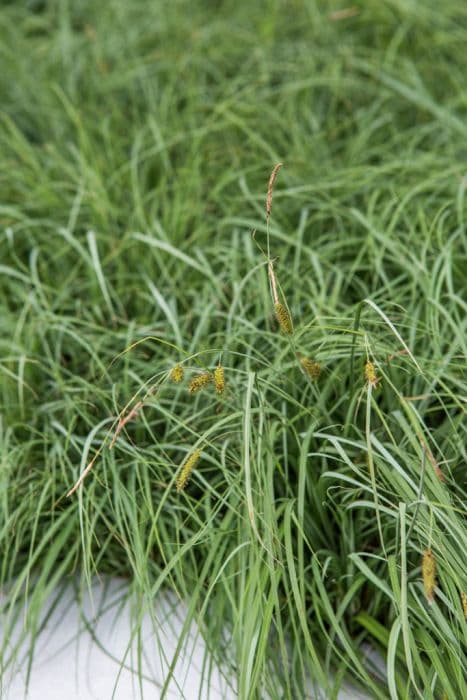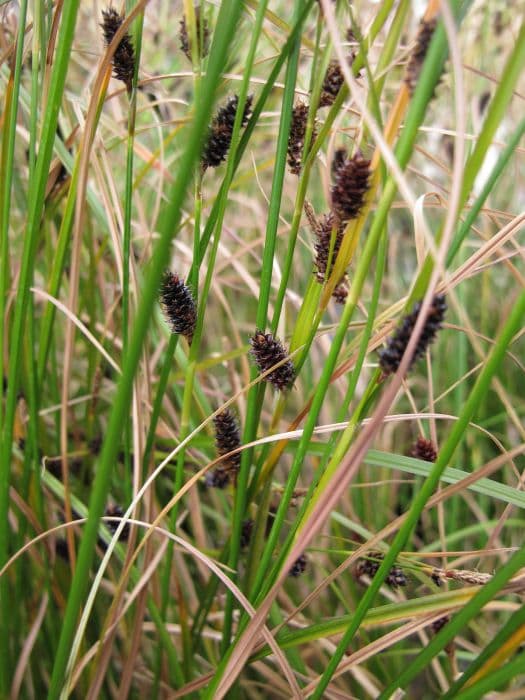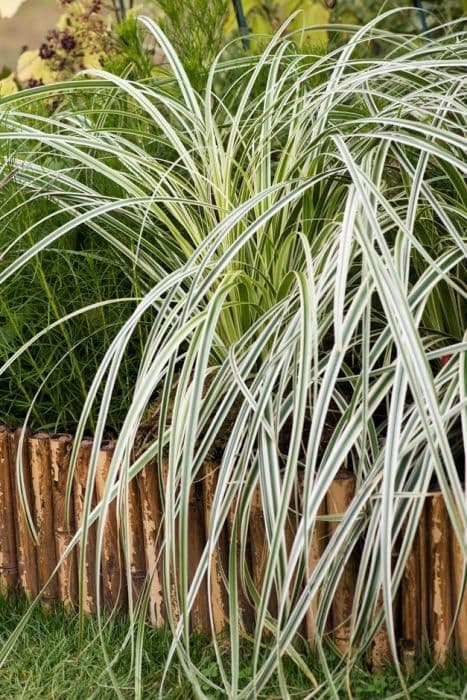New Zealand Hair Sedge Carex comans bronze-leaved











ABOUT
The Carex comans bronze-leaved, commonly known as bronze New Zealand sedge, is a graceful ornamental grass known for its striking foliage. It sports fine, hair-like leaves that have a unique bronze to copper coloring, lending a soft texture and a warm, rich hue to its overall appearance. This evergreen perennial has a cascading habit, with the leaves gently falling over and swaying in the breeze, creating a dynamic and fluid landscape presence. The plant bears small, inconspicuous flowers that are not particularly showy, as the main attraction is undoubtedly the dense, bronze foliage that provides year-round interest. The plant forms a mound-like shape with its arching leaves, contributing to an elegant and refined aesthetic in gardens.
About this plant
 Names
NamesFamily
Cyperaceae
Synonyms
New Zealand Hair Sedge, Bronze New Zealand Sedge, Bronze-Leaved New Zealand Sedge, Bronze Hair Sedge, Bronzita
Common names
Carex comans bronze-leaved.
 Toxicity
ToxicityTo humans
New Zealand Hair Sedge is not known to be toxic to humans. There are no well-documented cases of poisoning from ingesting this plant, and it is generally not considered a threat to human health.
To pets
New Zealand Hair Sedge is not known to be toxic to pets. It is generally considered non-toxic, and there are no widespread reports of pets being poisoned by consuming parts of this plant. However, as with any plant material, ingestion can sometimes lead to gastrointestinal upset in some animals.
 Characteristics
CharacteristicsLife cycle
Perennials
Foliage type
Evergreen
Color of leaves
Bronze
Height
1-2 feet (30-60 cm)
Spread
1-2 feet (30-60 cm)
Plant type
Herb
Hardiness zones
6-9
Native area
New Zealand
Benefits
 General Benefits
General Benefits- Ornamental Value: Carex comans bronze-leaved, commonly known as bronze New Zealand sedge, adds aesthetic appeal to gardens with its fine-textured, bronze-colored foliage that sways gracefully in the wind.
- Low Maintenance: This plant is relatively easy to care for, requiring minimal upkeep once established, making it ideal for low-maintenance landscapes.
- Drought Tolerance: Once established, Carex comans is quite tolerant of dry conditions, reducing the need for frequent watering.
- Erosion Control: With its dense growth habit, it can help to stabilize soil and prevent erosion on slopes and banks.
- Wildlife Habitat: It provides cover and nesting material for a variety of small wildlife, including birds and insects.
- Year-Round Interest: This sedge offers visual interest throughout all seasons, with its evergreen foliage providing color even in the colder months.
- Versatility in Landscaping: It can be used in a variety of landscape settings, including borders, rock gardens, and as groundcover or container plantings.
- Tolerant of a Range of Conditions: It can grow in a variety of soil types and tolerates partial shade, making it adaptable to different garden situations.
 Medical Properties
Medical PropertiesThis plant is not used for medical purposes.
 Air-purifying Qualities
Air-purifying QualitiesThis plant is not specifically known for air purifying qualities.
 Other Uses
Other Uses- Carex comans bronze-leaved, commonly known as Bronze New Zealand Sedge, can be used to create a natural dye for fabrics, producing subtle earthy tones due to its natural pigments.
- This plant can be incorporated into animal bedding, in particular for small pet enclosures, as it provides a soft, comfortable base and is non-toxic if ingested in small amounts.
- Bronze New Zealand Sedge can be used in floral arrangements and bouquets for its unique texture and color, adding an exotic touch to the design.
- The plant's dense foliage is ideal for miniature landscaping or creating fairy gardens, where it represents miniature trees or shrubs in a whimsical setting.
- Bronze New Zealand Sedge can be utilized in erosion control on sloped land due to its robust root system that helps stabilize the soil.
- It serves as a natural mulch for garden beds, where the dried foliage can help retain moisture and suppress weeds.
- The grassy leaves of Bronze New Zealand Sedge can be woven into small crafts, such as decorative baskets or mats, showcasing its durable texture.
- In garden ponds or water features, the plant can help provide cover for wildlife, like frogs, whilst contributing to the aesthetic of the space.
- For photographers or artists, Bronze New Zealand Sedge offers an excellent subject or backdrop due to its striking foliage and year-round interest.
- The plant can serve as a protective ground cover for beneficial insects and creatures, offering shelter and a micro-habitat in a diverse garden ecosystem.
Interesting Facts
 Feng Shui
Feng ShuiThe New Zealand Hair Sedge is not used in Feng Shui practice.
 Zodiac Sign Compitability
Zodiac Sign CompitabilityThe New Zealand Hair Sedge is not used in astrology practice.
 Plant Symbolism
Plant Symbolism- Resilience: The Carex comans bronze-leaved, commonly known as Bronze New Zealand Sedge, is known for its hardiness and ability to withstand a variety of growing conditions, symbolizing the ability to endure and thrive despite challenges.
- Flexibility: The plant's flowing, grass-like foliage that can sway in the wind without breaking is emblematic of adaptability and going with the flow in life's situations.
- Grace: With its bronzed, feathery tufts, Bronze New Zealand Sedge conveys a sense of elegance and understated grace, signifying beauty in simplicity.
- Natural beauty: Its subtle bronze coloration and fine texture symbolize the appreciation of natural beauty and the notion that true beauty does not have to be ostentatious to be appreciated.
- Growth: As a perennial plant that returns and grows every year, it represents growth and the idea of continual self-improvement and development.
 Water
WaterNew Zealand Hair Sedge prefers consistent moisture but does not like to be waterlogged, so it's crucial to water it thoroughly whenever the top inch of the soil feels dry. In general, this might mean watering with approximately 16-24 ounces of water for potted plants or 1-1.5 gallons per square yard for plants in the ground every week during active growth periods in the spring and summer. Cut back on watering in the fall and winter months to prevent rot, providing just enough to keep the soil from drying out completely, typically halving the amount you would give in the growing season.
 Light
LightNew Zealand Hair Sedge thrives in full sun to partial shade; however, its bronze foliage color intensifies with more sunlight. Ideally, it should be placed in a spot where it can receive at least 6 hours of direct sunlight daily. While it can tolerate some degree of shade, too much will result in less vibrant foliage and a looser growth habit.
 Temperature
TemperatureNew Zealand Hair Sedge is hardy and resilient, tolerating temperatures down to around 20 degrees Fahrenheit without significant damage. Its ideal growing temperatures range from 60 to 75 degrees Fahrenheit, but it can handle highs up to the mid-80s. Ensure the plant is not subjected to temperatures below 20 degrees Fahrenheit to prevent severe cold damage.
 Pruning
PruningNew Zealand Hair Sedge doesn't require frequent pruning, but it benefits from occasional grooming to maintain its shape and vigor. Prune back any brown or damaged foliage in early spring to promote fresh, new growth. The best time to give it a more thorough pruning is in late winter or early spring before new growth starts, trimming no more than one-third of its total height to keep it tidy.
 Cleaning
CleaningAs needed
 Soil
SoilNew Zealand Sedge thrives in well-draining soil with a pH range of 5.5 to 7.5. A soil mixture containing loam, peat, and sharp sand in equal proportions is ideal for providing the necessary drainage and aeration. Ensure that organic matter is mixed into the soil to retain some moisture while avoiding waterlogging.
 Repotting
RepottingNew Zealand Sedge should be repotted every 2 to 3 years to refresh the soil and to accommodate root growth. This frequency is efficient for maintaining plant health without causing undue stress. Spring is an optimal repotting period.
 Humidity & Misting
Humidity & MistingNew Zealand Sedge prefers moderate humidity levels and can tolerate a degree of fluctuation. Ensure that the area is well-ventilated to prevent excess humidity which could lead to fungal issues.
 Suitable locations
Suitable locationsIndoor
Ensure good light, don't overwater, keep away from heat sources.
Outdoor
Full sun to partial shade, well-draining soil, shelter from strong winds.
Hardiness zone
7-10 USDA
 Life cycle
Life cycleThe New Zealand Hair Sedge starts its life cycle when the seeds germinate, typically requiring a cool and moist environment to initiate growth. The seedlings then develop into juvenile plants, featuring narrow, bronze or reddish-brown leaves that begin to exhibit their characteristic curling and hair-like appearance. As the plant matures, it forms dense clumps and reaches its adult stage, flourishing in both wet and dry conditions, preferring full sun to light shade exposure. During its reproductive phase, the New Zealand Hair Sedge produces small, greenish-brown flowers that cluster on spikes emerging above the foliage in late spring to summer. After pollination, seeds are produced and dispersed, allowing for the continuation of the species. This sedge may live for several years, with its life span determined by growing conditions and care, and demonstrates a perennial growth habit, dying back in winter and resprouting in spring.
 Propogation
PropogationPropogation time
Spring-early summer
The Carex comans bronze-leaved, commonly known as New Zealand Hair Sedge, is typically propagated through division during the early fall or spring. The most popular method involves carefully digging up an established clump and gently teasing apart the plant into smaller sections, ensuring each section has a portion of roots. These divisions should then be immediately replanted at the same depth they were growing at originally, with ample water to help them establish. The soil should be kept consistently moist but not waterlogged until new growth is evident, indicating that the plant has successfully rooted. This technique allows for the quick proliferation of the New Zealand Hair Sedge, helping to maintain the ornamental characteristic bronze foliage throughout the garden.


![Japanese sedge [Everest]](/_next/image?url=https%3A%2F%2Fplants-admin.emdemapps.com%2Fimages%2Fplants%2F%2Fimages%2F604b5b6de0548.png&w=640&q=75)






